大学有机化学英文版答案共21页
- 格式:ppt
- 大小:2.48 MB
- 文档页数:11
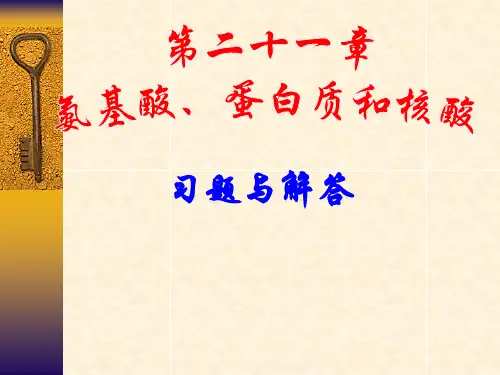

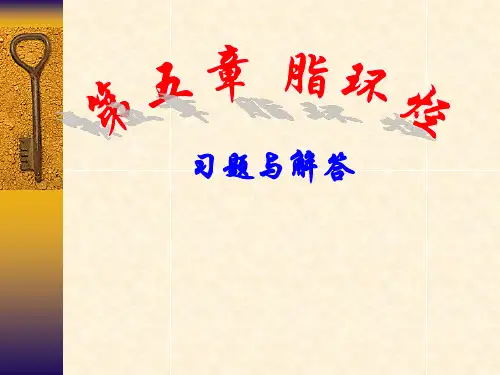

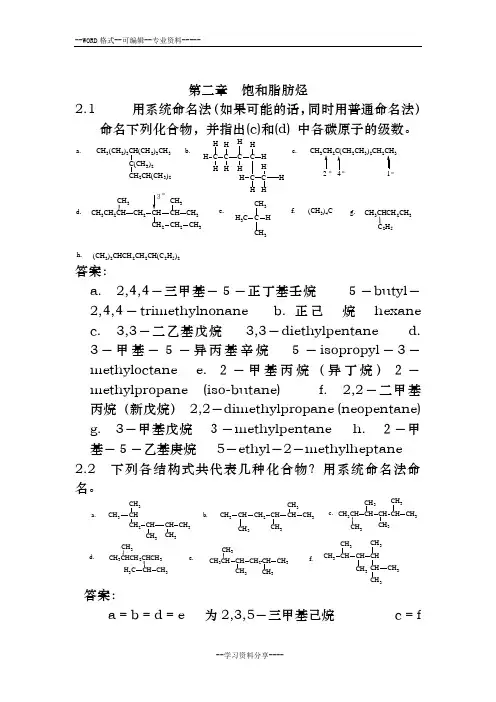
第二章 饱和脂肪烃2.1 用系统命名法(如果可能的话,同时用普通命名法)命名下列化合物,并指出(c)和(d) 中各碳原子的级数。
a.CH 3(CH 2)3CH(CH 2)3CH 3C(CH 3)22CH(CH 3)2 b.C H C H CH H C H HC H CHHc.CH 322CH 3)2CH 23d.CH 3CH 2CHCH 2CH 3CHCH CH 2CH 2CH 3CH 3CH 3e.C CH 3H 3C CH 3Hf.(CH 3)4Cg.CH 3CHCH 2CH 32H 5h.(CH 3)2CHCH 2CH 2CH(C 2H 5)21。
答案:a. 2,4,4-三甲基-5-正丁基壬烷 5-butyl -2,4,4-trimethylnonane b. 正己 烷 hexane c. 3,3-二乙基戊烷 3,3-diethylpentane d. 3-甲基-5-异丙基辛烷 5-isopropyl -3-methyloctane e. 2-甲基丙烷(异丁烷)2-methylpropane (iso-butane) f. 2,2-二甲基丙烷(新戊烷) 2,2-dimethylpropane (neopentane) g. 3-甲基戊烷 3-methylpentane h. 2-甲基-5-乙基庚烷 5-ethyl -2-methylheptane 2.2 下列各结构式共代表几种化合物?用系统命名法命名。
a.CH 3CHCH 32CH3CH 3CH 3 b.CH 3CH3CH 2CHCH 3CH CH 3CH 3c.CH 3CH 3CH CH 3CH 3CH CH 3CH 3d.CH 3CHCH 2CHCH 3CH 3CH H 3CCH 3e.CH 3CH CH CH 2CH CH 3CH 333f.CH 3CH CH 3CH CH3CH 3CHCH 33答案:a =b = d = e 为2,3,5-三甲基己烷c = f为2,3,4,5-四甲基己烷2.3 写出下列各化合物的结构式,假如某个名称违反系统命名原则,予以更正。
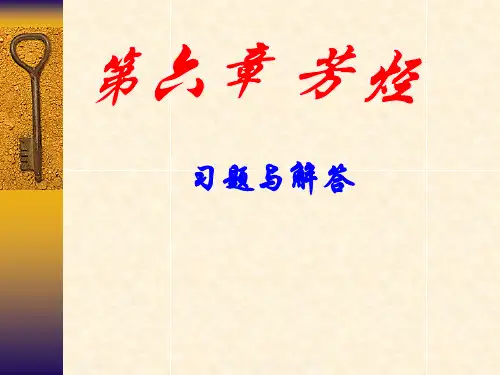

2011年有机化学自测题(英文版-中英对照)1、对于有机物 CH 3CH=C=CH 2, 请指出每个碳的杂化方式(从左至右).A. sp 3 sp 2 sp 2 sp 2B. sp 3 sp 2 sp sp 2C. sp 3 sp 2 sp spD. sp 3 sp sp sp 2. 属于亲电试剂的是: A. HNO 3 B. NaHSO 3C. H 2N -NH 2D. HCN 3. 属于亲核试剂的是:A. Br 2B. NaHSO 3C. H 2SO 4D. HCl4. 下列哪个取代基可以活化芳香环? A. —COOHB. —NO 2C. —OCH 3D. —SO 3H5. 不能发生碘仿反应的是:A. B. C. D.CH 3 C CH 3OCH 3CH 2OHC 6H 5CHOCH 3C-C 6H 56. 不存在几何异构(顺反异构)的是:CH 3CH=CHCH 3C 6H 5CH=CHBrA. B. D.C.ClCl ClClCl7. 具有芳香性的化合物是:ON HA.B.C.D.8. 用字母标记的碳碳键中,键长最长的是:A.aB. CH 3 CH CH 2bC. CH 3 C CHcD.CH 3 CH 3d9. 最稳定的碳正离子是:CH 3 C CH 32+CH 3 CH CH 3+A. B.CH 3 CH 2+C.CH 3+D.10. 能与亚硝酸作用生成黄色油状物的物质是:A. B. C. D.CH 3CH 2NH 2(CH 3CH 2)2NH(CH 3CH 2)3NNH 211. 最易溶于水的是:OHCH 3CHCH 2CH2OHA.B.C.E.3CH 2-CH -CH 212. 通常情况下不能与硝酸银反应生成氯化银的物质是: 13. 下列哪种物质不能和酰氯、酸酐、酯类通过亲核的酰基取代反应形成酰胺?A. (苯胺)B. (C 2H 5 )3NC. C 2H 5NHCH 3D. (C 2H 5 )3C-NH 2 14. 下列哪种试剂不能与2,4-戊二酮(乙酰丙酮)反应? (A) Na(B) Br 2(C) NaHSO 3(D) NaHCO 315. 具有p-π共轭体系的是:A. 1,3-butadieneB. ClCH=CHCH 2CH 3C. +CH 2CH=CH 2D.CH 2=CH-CH 2CH=CH 2 16. 具有p-π共轭体系的是:A. benzaldehydeB. 1,3-cyclohexadieneC. ClCH=CH 2D. ClCH 2CH=CH 2 17. 下列芳香环上的取代基,属于邻-对位定位基的是: A. -CHOB. -SO 3HC. -CH=CH 2D. -CN18. 碱性最强的是: A. CH 3C -Cl B. (CH 3)3C -Cl C. CH 2=CHCHCH 3D.ClA. NH 3B.(CH 3)2NHC. C 6H 5NH 2D. CH 3CONH 219. 碱性最弱的是20. 酸性最强的是COOHNO 2COOHCOOHH 3CA.B.C.D.OH21. 能用作路易斯碱的是:A. BF 3B. H 2SO 4C. Br +D. CN -22. 下列哪个化合物分子中同时包含有1°, 2°, 3° 和 4° 碳原子?A. 2, 2, 3-trimethylbutane 2,2,3-三甲基丁烷B. 2, 2, 3-trimethylpentane 2,3,3-三甲基戊烷C. 2, 3, 4-trimethylpentane 2,3,4-三甲基戊烷D. 3, 3-dimethylpentane 3,3-二甲基戊烷 23. 下列哪种碳水化合物能被溴水氧化? A. 果糖B 蔗糖C.葡萄糖D. 纤维素24. 下列哪个构象最稳定?CH 3H HH H 3CH 3HHCH 3H H 3C HH CH 3H H 3C HH HH CH 3A. AntiB. EclipsedC. GaucheD. Eclipsed25. 稳定性大小排序正确的是:H 3CCH(CH 3)2H 3CCH(CH 3)2(a)(b)3CH(CH 3)2H 3CCH(CH 3)2(c)(d)A. a>b>c>dB. d>a>b>cC. d>b>c>aD. d>c>a>b 26. 在单分子亲核取代反应中活性最高的是:A.methyl bromide 甲基溴B. ethyl bromide乙基溴C. 3-bromo-2-methylbutane 3-溴-2-甲基丁烷D. 2-bromo-2-methylbutane 2-溴-2-甲基丁烷27. 在双分子单核取代反应中活性最高的是:A.methyl bromide 甲基溴B. ethyl bromide乙基溴C. 3-bromo-2-methylbutane 3-溴-2-甲基丁烷D. 2-bromo-2-methylbutane 2-溴-2-甲基丁烷28.学生们在使用泰利(Thiele )毛细管法测定萘的熔点实验中,记录了如下测定结果。
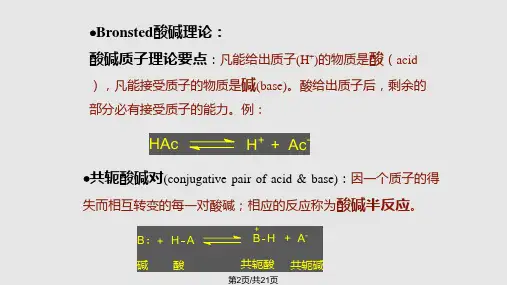
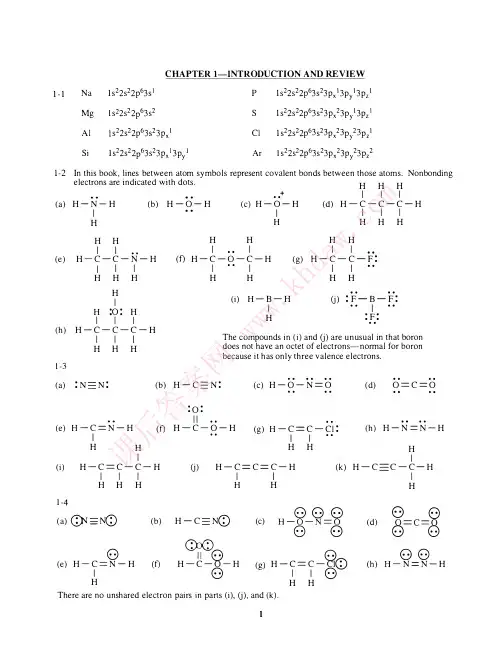
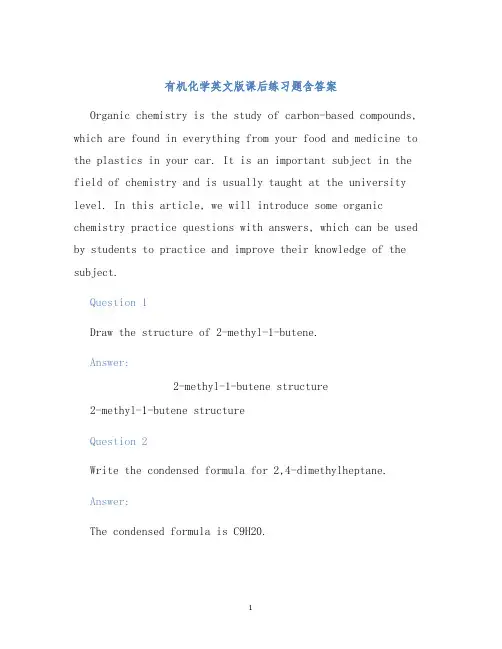
有机化学英文版课后练习题含答案Organic chemistry is the study of carbon-based compounds, which are found in everything from your food and medicine to the plastics in your car. It is an important subject in the field of chemistry and is usually taught at the university level. In this article, we will introduce some organic chemistry practice questions with answers, which can be used by students to practice and improve their knowledge of the subject.Question 1Draw the structure of 2-methyl-1-butene.Answer:2-methyl-1-butene structure2-methyl-1-butene structureQuestion 2Write the condensed formula for 2,4-dimethylheptane.Answer:The condensed formula is C9H20.Question 3Write the IUPAC name for CH3CH2CH2C(CH3)2CH3.Answer:The IUPAC name is 3,3-dimethylpentane.Question 4What is the functional group of butanoic acid?Answer:The functional group is a carboxyl group (-COOH).Question 5Which compound is more acidic: ethanol or acetic acid?Answer:Acetic acid is more acidic than ethanol because the presence of the carboxyl group in acetic acid makes it more acidic than ethanol.Question 6What is the mechanism of the reaction between ethene and hydrogen to form ethane?Answer:The mechanism is a catalytic hydrogenation reaction, which involves the addition of hydrogen to the carbon-carbon double bond in ethene to form ethane.Question 7What is the effect of increasing the size of the alkyl group on the boiling point of alkanes?Answer:Increasing the size of the alkyl group increases the boiling point of alkanes because larger molecules have stronger van der Waals forces of attraction, which require more energy to break.Question 8What is the difference between an electrophile and a nucleophile?Answer:An electrophile is an atom or molecule that is attractedto electrons and accepts a pr of electrons from another molecule during a chemical reaction. A nucleophile is an atom or molecule that has a lone pr of electrons and donates a pr of electrons to another molecule during a chemical reaction.Question 9What is the difference between an alkane and an alkene?Answer:An alkane is a hydrocarbon that contns only single bonds between carbon atoms. An alkene is a hydrocarbon that contns at least one carbon-carbon double bond.Question 10What is the difference between a saturated and an unsaturated hydrocarbon?Answer:A saturated hydrocarbon contns only single bonds between carbon atoms and is therefore。

得分 阅卷人 2011年有机化学自测题(英文版-中英对照)Ⅲ. Choose the best answers for each of the following questions.Single choice (only one choice is correct)for 1~701. For CH 3CH=C=CH 2, point out the hybridization of each carbon(from left to right)?对于有机物 CH 3CH=C=CH 2, 请指出每个碳的杂化方式(从左至右).A. sp 3 sp 2 sp 2 sp 2B. sp 3 sp 2 sp sp 2C. sp 3 sp 2 sp spD. sp 3 sp sp sp2. Which of the following is electrophilic reagent ?属于亲电试剂的是:A. HNO 3B. NaHSO 3C. H 2N -NH 2D. HCN3. Which of the following is nucleophilic reagent ?属于亲核试剂的是:A. Br 2B. NaHSO 3C. H 2SO 4D. HCl4. Which of the following substituents activates an aromatic nucleus?下列哪个取代基可以活化芳香环?A. —COOHB. —NO 2C. —OCH 3D. —SO 3H6. Which of the following structural formulas has no geometrical isomers? 不存在几何异构(顺反异构)的是:7. Which of the following is aromatic ?具有芳香性的化合物是:8. Which of the following lettered carbon-carbon bonds is the longest ? 用字母标记的碳碳键中,键长最长的是:9. Which of the following carbocations is most stable?最稳定的碳正离子是:15. Which of the following shows p-π conjugate system?具有p-π共轭体系的是:A. 1,3-butadieneB. ClCH=CHCH 2CH 3C. +CH 2CH=CH 2D.CH 2=CH-CH 2CH=CH 216. Which of the following shows p-π conjugate system?具有p-π共轭体系的是:A. benzaldehydeB. 1,3-cyclohexadieneC. ClCH=CH2D. ClCH2CH=CH217. Which substituent on an aromatic ring is ortho-para director?下列芳香环上的取代基,属于邻-对位定位基的是:A. -CHOB. -SO3HC. -CH=CH2D. -CN21. Which of the following can be used as Lewis base?能用作路易斯碱的是:A. BF3B. H2SO4C. Br+D. CN-22. Which of the following compounds contains 1°, 2°, 3°and 4°carbon atoms?下列哪个化合物分子中同时包含有1°, 2°, 3° 和 4° 碳原子?A. 2, 2, 3-trimethylbutane 2,2,3-三甲基丁烷B. 2, 2, 3-trimethylpentane 2,3,3-三甲基戊烷C. 2, 3, 4-trimethylpentane 2,3,4-三甲基戊烷D. 3, 3-dimethylpentane 3,3-二甲基戊烷24. Which one is the most stable?下列哪个构象最稳定?25. Which one of the stability order of the following is correct?稳定性大小排序正确的是:A. a>b>c>dB. d>a>b>cC. d>b>c>aD. d>c>a>b26. Which of the following shows the highest activity toward S N1 reaction?在单分子亲核取代反应中活性最高的是:A.methyl bromide 甲基溴B. ethyl bromide 乙基溴C. 3-bromo-2-methylbutane 3-溴-2-甲基丁烷D. 2-bromo-2-methylbutane 2-溴-2-甲基丁烷27. Which of the following shows the highest activity toward S N2 reaction?在双分子单核取代反应中活性最高的是:A.methyl bromide 甲基溴B. ethyl bromide 乙基溴C. 3-bromo-2-methylbutane 3-溴-2-甲基丁烷D. 2-bromo-2-methylbutane 2-溴-2-甲基丁烷28. In an experiment for the melting point determination of naphthalene with the set of Thiele bube, which record of the following is reasonable?学生们在使用泰利(Thiele)毛细管法测定萘的熔点实验中,记录了如下测定结果。
Answer for Comprehensive exercisesⅠ. Name each of the followings.1. 2-pentanone (2-戊酮)2. propene (丙烯)3. ethanol (乙醇) (4) benzoic acid (苯甲酸)5.N,N-dimethylformamide (N,N-二甲基甲酰胺)6.methylcyclopentane (甲基环戊烷)7.phenylethanone (苯乙酮) 8.2R,3S-2,3-dihydroxybutanedioicacid (2R,3S-2,3-二羟基丁二酸)9.acitic anhydride (ethanoic anhydride 乙酸酐)10.1,4-putanediamine (1,4-丁二胺, 1,4-diaminobutane 1,4-二氨基丁烷)11.ethyl benzoate (苯甲酸乙酯) 12.ethanoyl chloride (acetyl chloride 乙酰氯)Ⅱ.Write the structural formula for each of the followings1. 2. 3. CH 3CHCHCH 2CH 2CH 2CH 3CH 3CH 2CH 3CH C=C CH 2CH 3H H 3C 3 CH 3C -C C -CH 2CH 3 CH 34.5. 6.7. 8Ⅲ. Choose the best answers fo r…1C 2B 3C 4A 5D 6A 7D 8A 9B 10A 11B 12C 13A 14C 15C 16A 17B 18A 19B 20 D 21A 22D 23A 24A 25D 26A 27A 28C 29C 30D 31BCD 32AD 33ABC34AC 35CD 36AB 37BCD 38ABCD 39BC 40ADⅣ. Complete reactions1.2.3. 4. 5.6. OH CH 2CH 2CH 3(CH 3CH 2)3NCOOH H H 2N CH 3CHO Br 22+ H 2OOH OH Br Br 3-C -OH O +CH 3CH 2+CH 3-C -OCH 2CH 3O + H 2O CH CH 3CH 2-+Br 2+CH 3-CH -Br HBr C 2H 5CH=CH 2 + H ClC 2H 5CH -CH 3 Cl CH 3-C -CH 3 + I 2 + NaOH HCOONa OC 2H 5OH C 2H 5OC 2H 5 H SO (conc.)o + H 2O+CH 3-CH 3CH=NH-NO 2O 2NH 2O 7. 8. 2 CH 3CHO -CH 3CH=CHCHO + H 2OCH 3NO 2+ HNO 324CH 3NO 2O 2N CH 3NO 2NO 2+9.++CH 33H +310. HO COONa + CO 2 + H 2O 11.HN CH3CH 3+ HNO 2ON -NCH 3CH 3+ H2O12. Br CH 325CH313. 14. COOH OH H 2SO 4(CH CO)OCOOHOCCH 3ONH 2+ NaNO 2 + 2 H 2SO 40~5℃N 2+HSO 4-15.16.OH CH 3H 3C KMnO H OCH3H 3C 17. CH 3C -NH 2O + H2O NaOHCH CH 3CH =CHCHO (1) NaBH (2) H 3O CH 3CH =CHCH 2OH18.OH CH 2OH + HCOO -19. 20. C H 3-CH -CH 2O + CH 3CH 2OH CH 3COONaCH 3-CH -CH 2OCH 2CH 3OHⅤ. Differentiate the following groups of compounds1.CH 3CH 2NH 2(CH 3CH 2)2NH(CH 3CH 2)3N 3clear solution don't reactHCI 3(-)2. 2-pentanone(-)(-)CO 23-pentanonebenzoic acid Ⅵ. Preparation of the following coumpound s……1. Synthesize 2,6-dibromo-4-nitrobenzoic acid from toluenesee [see question 4-4 (2)]2. Synthesize 2-hydroxybutanoic acid from butanoic acid [see question 9-8(2)]3. Synthesize butanedioic anhydride from ethanol [see question 10-8(2)]4. Synthesize 2,4,6-tribromophenol from aniline [see question 11-10(2)]Ⅶ.Deduce structure.1. CH 3CHCH(CH 3)2OHHCI 3HOOCCH(CH 3)22.3. .若A 不能溶于氢氧化钠,则A 可能为:CH 3CHCH 2CH 2CH 3OH HCI HOOCCH 2CH 2CH 3ABCH OH CH 3-CH -C O OCH 3CH 2COOH CH 3-CH -C OOH CH 2COOCH 3(B )(C )CH3-CH -C CH 2-C O O (A )3CHCOOCH 3CH 2COOCH 3(D )+ 3 HBr A B OCH 3Ⅶ. Explain concepts1.racemate: A mixture of equal parts of enantiomers is called racemate or racemic mixture.2. nucleophilic addition: In the reaction of aldehydes or ketone with nucleophilic reagents such as HCN, HOR, etc, the nucleophilic anion adds first to the carbonyl carbon to form an intermediate, then, the H+ adds rapidly to the carbonyl oxygen to form neutral additional product. First step is the slowest, so this reaction is called as nucleophilic addition.3. chiral carbon atom: A carbon bonded to four different atoms or groups are called chiral carbon atom.4. enantiomer: optical isomers that are mirror images. Enantiomers have identical physical properties except for the rotation of plane-polarized light.5. reducing sugar: Carbohydrates that can directly or indirectly reduce Fehling’s, Tollens’,Benedict’s reagents are termed as reducing sugars.。
各大学教材课后习题答案网址《线性代数》(同济第四版)课后习题答案(完整版)高等数学(同济第五版)课后答案(PDF格式,共527页)中国近现代史纲要课后题答案曼昆《经济学原理》课后习题解答21世纪大学英语读写教程(第三册)参考答案谢希仁《计算机网络教程》(第五版)习题参考答案(共48页)《概率论与数理统计》习题答案《模拟电子技术基础》详细习题答案(童诗白,华成英版,高教版)《机械设计》课后习题答案(高教版,第八版,西北工业大学)《大学物理》完整习题答案《管理学》课后答案(周三多)机械设计基础(第五版)习题答案[杨可桢等主编]程守洙、江之永主编《普通物理学》(第五版)详细解答及辅导新视野大学英语课本详解(四册全)21世纪大学英语读写教程(第四册)课后答案新视野大学英语读写教程3册得课后习题答案新视野大学英语第四册答案(第二版)《中国近现代史》选择题全集(共含250道题目与答案)《电工学》课后习题答案(第六版,上册,秦曾煌主编)完整得英文原版曼昆宏观、微观经济学答案《数字电子技术基础》习题答案(阎石,第五版)《电路》习题答案上(邱关源,第五版)《电工学》习题答案(第六版,秦曾煌)21世纪大学英语读写教程(第三册)课文翻译《生物化学》复习资料大全(3套试卷及答案+各章习题集)《模拟电子技术基础》课后习题答案(共10章)《概率论与数理统计及其应用》课后答案(浙江大学盛骤谢式千编著)《理论力学》课后习题答案(赫桐生,高教版)《全新版大学英语综合教程》(第四册)练习答案及课文译文《化工原理答案》课后习题答案(高教出版社,王志魁主编,第三版)《国际贸易》课后习题答案(海闻P、林德特王新奎)大学英语综合教程1-4册练习答案《流体力学》习题答案《传热学》课后习题答案(第四版)高等数学习题答案及提示《高分子化学》课后习题答案(第四版,潘祖仁主编)马·克思主·义基本原理概论答案《计算机网络》课后习题解答(谢希仁,第五版)《概率论与数理统计》优秀学习资料《离散数学》习题答案(高等教育出版社)《模拟电子技术基础简明教程》课后习题答案(杨素行第三版)《信号与线性系统分析》习题答案及辅导参考(吴大正版)《教育心理学》课后习题答案(皮连生版)《理论力学》习题答案(动力学与静力学)选修课《中国现当代文学》资料包机械设计课程设计——二级斜齿圆柱齿轮减速器(WORD+原图)《成本会计》配套习题集参考答案《概率论与数理统计》8套习题及习题答案(自学推荐)《现代西方经济学(微观经济学)》笔记与课后习题详解(第3版,宋承先)《计算机操作系统》习题答案(汤子瀛版,完整版)《毛·泽东思想与中国特色社会主·义理论体系概论》有史以来最全面得复习资料!!!《线性代数》9套习题+9套相应答案(自学,复习推荐)《管理理论与实务》课后题答案(手写版,中央财经大学,赵丽芬)统计学原理作业及参考答案机械设计课程设计——带式运输机得传动装置得设计《物理学》习题分析与解答(马文蔚主编,清·华大学,第五版) 《新编大学英语》课后答案(第三册)《通信原理》课后习题答案及每章总结(樊昌信,国防工业出版社,第五版)《c语言程序与设计》习题答案(谭浩强,第三版)《微生物学》课后习题答案(周德庆版)新视野第二版全四册听说教程答案《宏观经济学》课后答案(曼昆,中文版)《电力电子技术》习题答案(第四版,王兆安,王俊主编)《土力学》习题解答/课后答案《公司法》课后练习及参考答案《全新版大学英语综合教程》(第二册)练习答案及课文译文新视野大学英语视听说第三册答案《工程力学》课后习题答案(梅凤翔主编)《理论力学》详细习题答案(第六版,哈工大出版社)《成本会计》习题及答案(自学推荐,23页)《自动控制原理》课后题答案(胡寿松,第四版)《复变函数》习题答案(第四版)《信号与系统》习题答案(第四版,吴大正)《有机化学》课后答案(第二版,高教版,徐寿昌主编)《电工学——电子技术》习题答案(下册)《财务管理学》章后练习参考答案(人大出版,第四版)现代汉语题库(语法部分)及答案《概率论与数理统计》习题详解(浙大二、三版通用)《有机化学》习题答案(汪小兰主编)《微机原理及应用》习题答案《管理运筹学》第二版习题答案(韩伯棠教授)《古代汉语》习题集(附习题答案)福建人民出版社《金融市场学》课后习题答案(张亦春,郑振龙,第二版)《公共关系学》习题及参考答案(复习必备)现代汉语通论(邵敬敏版) 词汇语法课后练习答案《国际经济学》教师手册及课后习题答案(克鲁格曼,第六版)《教育技术》课后习题答案参考(北师大)《金融市场学》课后答案(郑振龙版)《组织行为学》习题集答案(参考下,还就是蛮好得)《分析化学》课后习题答案(第五版,高教版)大学英语精读第3册答案(外教社)《国际经济学》习题答案(萨尔瓦多,英文版)《复变函数与积分变换》习题答案《信息论与编码》辅导PPT及部分习题答案(曹雪虹,张宗橙,北京邮电大学出版社)《宏观经济学》习题答案(第七版,多恩布什)《物理化学》习题解答(天津大学, 第四版,106张)新视野大学英语视听说教程第一册《机械制造技术》习题集与答案解析新视野大学英语听说教程2册听力原文及答案下载管理学试题(附答案)《材料力学》详细辅导及课后答案(PDF格式,共642页)六级词汇注解《大学基础物理学》课后答案(共16个单元)《管理学——原理与方法》课后习题答案新视野2版第三册(大2上学期用)曼昆《经济学原理》中文第四版、课后习题答案-清晰图片版《数据库系统概论》课后习题(第四版)大学数学基础教程课后答案(微积分)《投资学》课后习题答案(博迪,第四版)流体力学课后答案(高教版,张也影,第二版)《语言学概论》习题答案(自考,新版教材)《统计学》各章练习题答案《数字电子技术基础》课后习题答案(完整答案版)《积分变换》习题答案(配套东南大学张元林编得)《中级财务会计》习题答案(第二版,刘永泽)《计算机网络》课后习题答案(第5版与第4版)《单片机原理及应用》课后习题答案(张毅刚主编,高教版)《金融工程》课后题答案(郑振龙版)《液压传动》第2版思考题与习题解答(共36页)《动物学》习题集与答案(资料相当丰富)《高频电子线路》习题参考答案(第四版)《国际经济法》课后参考答案大学英语四级十年真题+听力《信号与系统》习题详解(奥本海姆版)《电路分析》课后答案及学习指导(第二版,胡翔骏,高教版)《C语言设计》(谭浩强,第三版)227页新视野大学英语课后习题答案1-4册全集《数字电路与逻辑设计》课后习题答案,讲解详细《电路》第五版课后答案《材料力学》详细习题答案及辅导(第四版,刘鸿文)《传播学教程》课后答案(郭庆光主编,完整版)《物理化学》习题答案与课件集合(南大)《金融市场学》电子书(张亦春,郑振龙,第二版)毛邓三95%考点高等教育出版社《毛·泽东思想与中国特色社会主·义道路》(09版,原毛邓三)课后题答案《线性代数》课后习题答案(陈维新,科学出版社)自动控制原理习题集(自学辅导推荐)《现代通信原理》习题答案(曹志刚版)高等数学上下《习题PPT》《数据结构习题集》答案(C版,清·华大学,严蔚敏)《大学物理学》习题解答《物理化学》习题答案(南大,第五版)《机械原理》复习精要与习题精解(第7版,西北大学)《宏观经济学》答案(曼昆,第五版,英文版)pdf格式《化工热力学》习题与习题答案(含各种版本)《材料力学》习题答案教育统计与测量管理心理学(自考必备资料,牛逼打印版)离散数学习题解答(第四版)清·华大学出版社货币银行学《技术经济学概论》(第二版)习题答案《毛·泽东思想与社会主·义建设理论题概论》精炼考试题目,耐心整理《数字信号处理》课后答案及详细辅导(丁美玉,第二版)《语言学概论练习题》答案《会计电算化》教材习题答案(09年)《数据库系统概论》习题答案(第四版)《微观经济学》课后答案(平狄克版)《控制工程基础》课后习题解答(清·华版)《高分子化学》习题答案(第四版)《电机与拖动基础》课后习题答案(第四版,机械工业出版社,顾绳谷主编)《机械工程测试技术基础》(第三版,熊诗波等主编)课后答案《宏观经济学》课后答案(布兰查德版)《机械原理》习题答案与超多例题(西北工业大学,第六版)《大学物理基础教程》课后习题答案(第二版,等教育出版社)简明乐谱基础知识《语言学教程》课后答案《公司理财》课后答案(英文版,第六版)《信息论与编码》学习辅导及习题详解(傅祖芸版)《遗传学》课后习题答案(朱军主编,完整版)现代人心理实战700题处世韬略《自动控制原理》习题答案《普通动物学》完整课后答案(刘凌云,郑光美版)《微机原理》作业答案(李继灿版)尼尔·波兹曼《娱乐至死》《电力电子技术》习题答案(第4版,西安交通大学)大学英语四级(CET-4)历年真题大全[89-07年39套](精品级)753页word《通信原理》习题答案《普通化学(第五版)》习题详解(配套浙大编得)经济法课后复习及思考答案《结构化学基础》习题答案(周公度,北大版)财务管理学课后答案荆新王化成《C++程序设计》课后习题答案(第2版,吴乃陵,高教版)药用植物得两份习题(自己感觉比较有用)《数学物理方法》习题解答案详细版(梁昆淼,第二版)《机械制图》习题册答案(近机类、非机类,清·华大学出版社)《控制工程基础》习题答案(第二版,燕山大学)《画法几何》资料包(含习题答案,自学辅导课件)《畜禽解剖学与组织胚胎学》习题答案参考《统计学》课后习题答案(周恒彤编)《西方经济学简明教程》课后习题全解(尹伯成,上海人民出版社)《汽车理论》课后答案详细解答(余志生,机械工业出版社)《数学物理方法》(第三版)习题答案新视野听力原文及课后答案新编大学英语4(外研版)课后练习答案《材料力学》习题答案(单辉祖,北京航空航天大学)大学英语精读第3册课文及课后答案《自动控制原理》课后习题答案———胡寿松,第五版《数据库系统原理与设计》课后答案(第四版,王珊,萨师煊)《数字电子技术基础》详细习题答案(阎石第四版)财经应用文笔记《管理学》课后习题答案(罗宾斯,人大版,第7版)《概率论与数理统计》习题答案(复旦大学出版社)《数字信号处理——基于计算机得方法》习题答案(第二版)《传热学》课后答案(杨世铭,陶文铨主编,高教版)C语言资料大全(有课后答案,自学资料,C程序等)毛邓三重点归纳《电力拖动自动控制系统》习题答案逄锦聚《政治经济学》(第3版)笔记与课后习题详解《概率论与数理统计》课后习题解答(东南大学出版社)《有机化学》课后习题答案(胡宏纹,第三版)《常微分方程》习题解答(王高雄版)▆▆▆▆▆▆▆▆▆▆▆▆▆▆▆▆▆▆▆▆▆▆▆▆▆▆▆▆▆▆【因为太多了,没办法再粘贴到这里了,更多答案,直接进入下面这个搜索就好】。
第一章绪论2. (1) (2) (5) 易溶于水;(3) (4) (6) 难溶于水。
4.80*45%/12=3 80*7.5%/1=6 80*47.5%/19=2 C 3H6F2第二章有机化合物的结构本质及构性关系1. (1) sp 3(2) sp (3) sp 2 (4) sp (5) sp 3 (6)sp2第四章开链烃1. (1) 2- 甲基-4,5- 二乙基庚烷(2) 3- 甲基戊烷(3) 2,4- 二甲基-3- 乙基戊烷(4) ( 顺)-3- 甲基-3- 己烯or Z-3- 甲基-3- 己烯(12) 3- 甲基-1- 庚烯-5- 炔2.CH3(1)CH3CH2CH C H (CH2)4CH3 (2) (CH3)2CHCH2CH2CH3C2H5CH3C H3(3) (CH3)2CHC CH(CH3)2 (4) CH3CH2CH C(CH2)3CH3C2H5 (5) (CH3)2CHC CH(CH2)3CH3C2H5H3C(6) C CHHCH2CH2CH3H3C CH2CH3(7) (8) (CH3)2CHC C C CCH(CH3)2C CH CH3(9)H3CC CCH2 CHC CH HHCH3H5C2 C2H5(1 0) C CH3CCH37.(1)Br BrBr H HCl Cl H(2) (3)HBrH H H HH HBrBr11.(1) CH3CHCH2CH2CH3 (2) (CH3)2CCH2CH3Br BrCH3(3) (CH3)2CCH( C H3)2(4) C H3CH2CC2H5BrBr 12.(1) (2) CH3CH2CH2CH3 (3) CH3CHCH2CH3(CH3)2CCH2CH3ClOHH3C (4) CH3COOH + C OH3C (5) C H3CH2CHCH3OSO3HOC H3CH2CHCH3OH(6) CH3CH2CH2CBr2C H3 (7)C H3CCH2CH3Br(8) ( C H3)2CCH CH2 + (CH3)2C CH C H2BrCH CH2CHO (9) ( CH2C CH C H2 ) n (10)+ ( CH2 C ) nClCl14. (5) >(3) >(2) >(1) >(4) 即:+HCH + CH2=CHC 3 >(CH3) 3C+HCH +H +H>CH3CH2C 3 >CH3CH2CH2C 2>(CH3) 2CHC216. (1)1-戊烯√溴褪色+ ×Ag(NH 3)21-戊炔B r 2/CCl 4室温,避光√溴褪色√灰白色戊烷×(2)1-丁炔+Ag(NH 3)2√灰白色↓√溴褪色Br2/CCl 42-丁炔×室温,避光×丁烷×(3)1,3-丁二烯√溴褪色+ ×Ag(NH 3)2Br2/CCl 4 1-己炔√溴褪色√灰白色↓2,3-二甲基丁烷×17.(2)H2OCH CH [CH2 CHOH]H2SO4,H g SO4C H3CHO21 A B.10.(1)CH3-CH=CH2KMnO / H4 CH3COOH(2)CH3- C≡CH+HB(r 2mol)CH 3CBr2CH3HBr (1mol )(3)CH3- C≡CH CH3-C=CH2 Br2 CH3CBr2CH2BrBr第四章环烃2.C(CH 3 )3(1) (2) (3)CH 33.(1)(3)C H 3Br反式顺式4.Br ClCl +Cl(1)(2)(3)( C H 3)2CCH (CH 3)2 O 2NC H 3BrClB r(4)(5)H 3CCOOHC 2H 5+ Br C 2H 5(6) (CH 3)3CCOOH(7) CH 3COCH 3(8) 1molCl2/ h, 苯/ 无水 AlCl 3CH 3N H COCH 3NO 2(9) (10)SO 3HC H 37. (2) 有芳香性 10.第六章 旋光异构6-32. (1) × (2) × (3) × (4) √ (5) √ (6) √7. [ ] 20 Dc l18.85.678 20 166.2第七章卤代烃2、Cl白↓ClAgNO 3/乙醇,室温(2)×白↓AgNO 3/乙醇,加热××Cl4、第八章醇、酚、醚1. (1) 3- 甲基-3- 戊烯-1- 醇(2) 2- 甲基苯酚(3) 2,5- 庚二醇(4) 4- 苯基-2- 戊醇(5) 2-溴-1- 丙醇(6) 1- 苯基乙醇(7) 2- 硝基-1- 萘酚(8) 3- 甲氧基苯甲(9) 1,2- 二乙氧基乙烷(乙二醇二乙醚)3、(2)(1)4. (1) 甲醇分子间氢键(6) 邻硝基苯酚分子内氢键、分子间氢键5、(1)H3 CO OH(5) (6) (7)H OHCH2I OCH 36、(1)OH+O,△浓硫酸,△H 3OHBr(2)浓硫酸,△Br2/CCl4OHBrKOH/EtOH△10、OH O ClA B C D第九章醛、酮、醌一、命名下列化合物。
2. (1) (2) (5)4.80*45%/12=3第一章易溶于水;(3) (4) (6) 难溶于水。
80*7.5%/1=6 80*47.5%/19=2 C 3H s F2第二章有机化合物的结构本质及构性关系1. (1) sp 3 (2) sp ⑶sp 2 ,、,一、(4) sp (5)sp3 (6)sp 2第四章开链1.(1) 2-甲基-4,5-二乙基庚烷(4)( 顺)-3-甲基-3-己烯or Z-3-2.(2)3-甲基戊烷甲基-3-己烯煌(3) 2,4- 二甲基-3-乙基戊烷(12) 3- 甲基-1-庚烯-5-快11. CH3CH3CH2CHCH(CH2)4CH3 (2) (CH3)2CHCH2CH2CH3 C2H5CH3 CH3 (CH3)2CHC CH(CH3)2C2H5(CH 3)2CHC —CH(CH 2)3CH3C2H5⑺(9 )7./H、CH3(4)(6)(8)CH3CH2CH— C(CH2)3CH3H3cA /H/C-C\CH2CH2CH3(C H3)2CH C= C C= CCH(CH3)2H5c入/(10)H3C/C=C、C2H5CH3Br(1) CH3CHCH2CH2CH3 (2) (CH3)2CCH2CH3Br(3) (CH3)2CCH(CH3)2BrCH3(4)CH3CH2CC2H5Br Br12.(1) (CH3)2CCH2CH3 (2) CH3cH2cH2cH3(3) CH3cHCH2cH3C l OH(4) CH3COOH + H3c、C -OH3C'(5) CH3CH2CHCH3OSO3HCH3CH2CHCH3OH(6) CH3CH2CH2CBr2CH3 (7)CH3CCH2CH3Br(8)(CH 3)2CCH —CH 2 + (CH 3)2C —CHCH 2BrCH —CH 2(9) (CH 2C —CHCH 2) n + (CH 2—C) nClKMnO 4/H(10) (1) CH-CH=CHCHCOOH(2) CH-OCH+HBr( 2mol> CHQBr z CH HBr(1mol)Br 2(3) CH-O CHCH-C=CHCHCBr z CHBrBr第四章环煌2.14. (5) > (3)>(2) CH=CHCHCH >(CH3)3C +>(4) 即: 16. (1)1-戊烯 1-戊快 (2)1-丁快 2-丁快1,3-丁二烯 1-己快17.21>CHCH 2CHCH>CH€HCHC +H2>Br 2/CCl 4室温,避光.,澳褪色■,灰白色JAg(NH 3)2+卜 -----------------► X(2)CH —CHBr 2/CCl 4H 2O (CH 3)2CHCrtAg(NH 3)2+XBr 2/CCl 4,澳褪色室温,避光’ x澳褪色 澳褪色H 2so 4,HgSOAg(NH 3)2+ XA [CH 2—CHOH]4>CH 3CHOCHOCl(10)I6-3HHCH.OH CH.OH Cl ---- Br Br ——Cl—H H —L OCH 5 CH 5CII 3 CH? S- R-S ・R-2. (1) X (2) X (3) X (4) V (5) V (6) VC(CH 3)34. ⑴ Br(6) (CH83C COOHCOOH⑷H 3c CH 3 O 2N(2)Cl \'>Cl + 履 / Cl、ClBr(3) (CH 3)2C CH(CH 3)2Br⑸+ BrC 2H 5C 2 H 5 (7) CH 3COCH 3(8) ImolCl 2 / h , 苯/无水 A1C13第六章旋光异构6、[ ]20 18.8D c l 5.678 20 1(IJCiIhCHBrCI l 2Br C2H5c =CII C2H5CCH3(2)C1CH=CHCH 2OCH3 (3)C 6H 5CH=CHCH 2CH 3 (4)NCCH 2(CH2)I CH 2CNC (CH 3)3(5)C 6H 5CIb-^3^-C(CII 3)3 + C 6H 5C1I 2-<Z)>(6)< >(7) (CH3hCHOCnHs + CH<H=CH 2 (8) C 6H 5CH 2ONO2 + AgBr第八章醇、酚、醛1. (1) 3-甲基-3-戊烯-1-醇(2) 2- 甲基苯酚 (3) 2,5- 庚二醇(4) 4- 苯基-2-戊醇(5) 2-澳-1-丙醇(6)1- 苯基乙醇⑺2-硝基-1-蔡酚 (8) 3-甲氧基苯甲(9)1,2- 二乙氧基乙烷(乙二醇二乙醛)3、⑴2、4、66.27.Cl⑵:第七章卤代煌OH 浓硫酸,△OHH3+O,A浓硫酸,△OH10、B第九章醛、酮、醍、命名下列化合物。
有机化学答案(Organic chemistry answer)(1) ① Br2 / CCl4 ② 银氨溶液 (2) 银氨溶液12 (1) 通入硝酸银的氨溶液中, 乙炔迅速生成乙炔银沉淀而除去.(2) 用林德拉催化剂使乙炔氢化为乙烯.13, (1) 1,2 - 加成快, 因为1,2 - 加成活化能低于1,4 - 加成活化能.(2) 1,4 - 加成产物比1,2 - 加成产物的能量低, 更稳定.14, 可利用 "动力学控制" 和 "热力学控制" 理论解释.15, 此烃为: CH2 = Chch = Chch = CH2 (有顺反异构体)第五章脂环烃1, (1) 1 - 甲基 - 3 - 异丙基环己烯 (2) 1 - 甲基 - 4 - 乙烯基- 1,3 - 环己二烯(3) 1,2 - 二甲基 - 4 - 乙基环戊烷 (4) 3,7,7 - 三甲基双环[4.1.0] 庚烷(5) 1,3,5 - 环庚三烯 (6) 5 - 甲基双环 [2.2.2] - 2 - 辛烯 (7) 螺 [2.5] - 4 - 辛烯3, 略4, (1)) (2), (3) 无 (4) 顺, 反两种 (5) 环上顺反两种, 双键处顺反两种, 共四种(6) 全顺, 反 - 1, 反 - 2, - 4 共四种反5.6.7, 该二聚体的结构为: (反应式略) 8.9.单环芳烃1, 略2.3 (1) (2) 叔丁苯对氯甲烷 (3) 对硝基乙苯 (4) 苄醇 (5) 苯磺酰氯(6) 2,4 - 二硝基苯甲酸 (7) 对十二烷基苯磺酸钠 (8) 1 - 对甲基苯 - 1 - 丙烯4, (1) ① Br2 / CCl4 ② 加浓硫酸 (或hno3 + H2SO4)(2) ① Ag (NH3) 2no3 ② Br2 / CCl46 (1) AlCl3 clso3h7 (1) a错, 应得异丙苯; b错, 应为氯取代α - H.(2) a错, 硝基苯部发生烷基化反应; b错, 氧化应得间硝基苯甲酸.(3) a错, coch3为间位定位基; b错, 应取代环上的氢.8, (1) 间二甲苯 > > > 苯对二甲苯甲苯(2) 甲苯 > > > 硝基苯苯溴苯(3) 对二甲苯 > > > 对苯二甲酸甲苯对甲苯甲酸(4) 氯苯对氯硝基苯 2,4 - 二硝基氯苯 > >9, 只给出提示 (反应式略):(1) 4 - 硝基 - 2 - 溴苯甲酸: ① 硝化② 溴代 (环上) ③ 氧化3 - 硝基 - 4 - 溴苯甲酸: ① 溴代 (环上) ② 氧化③ 硝化(2) ① 溴代 (环上) ② 氧化(3) ① 氧化② 硝化(4) ① 硝化② 溴代 (环上)(5) ① 硝化② 氧化(6) ① 烷基化② 氧化③ 氯代10, 只给出提示 (反应式略):(1) 以甲苯为原料: ① Cl2 / Fe ② Cl2, 光(2) 以苯为原料: CH2 = CH2 ①, alc3 ② Cl2, 光③ 苯, AlCl3(3) 以甲苯为原料: ① Cl2, 光② CH3Cl, AlCl3 ③ 甲苯, AlCl3(4) 以苯为原料: ① ch3ch2cocl, alc3 ② Zn - Hg + HCl.11 (1) (2) 乙苯间二甲苯 (3) 对二甲苯 (4) 异丙苯或正丙苯(5) 间甲乙苯 (6) 均三甲苯12, 两种: 连三溴苯; 三种: 偏三溴苯; 一种一元硝基化合物: 均三溴苯.13.14,15, 略第七章立体化学1 (1), 3 (2), 4 (3),2 (4), 8 (5) 0 (6) 4 (7) 0 (8) 2 (9) 32, 略 3 (1) (4) (5) 为手性分子4, 对映体 (1) to (5) 相同 (2) to (6) 非对映体 (3) (4)5.7, (4) 为内消旋体8.(1) (2); (5), (6), (7), (8) 为对映体(5) to (7); (5) (8); (6), (7); (6), (8) 为非对映体9. (a) ch3ch2ch (OH) ch = CH2 (b) ch3ch2ch (OH) ch2ch310. (a) CH2 = chch2ch (CH3) ch2ch3 (b) CH3CH = Chch (CH3) ch2ch3(c) ch3chch2ch (CH3) ch2ch311.卤代烃1, (1) 1,4 - 二氯丁烷 (2) 2 - 甲基 - 3 - 氯 - 6 - 溴 - 1,4 - 己二烯 (3), (and) - 2 - 氯 - 3 - 己烯(4) (2 - 甲基 - 3 - 乙基 - 4 - 溴戊烷 (5) 对氯溴苯 (6) (3 - 氯环己烯(7) 四氟乙烯 (8) 4 - 甲基 - 1 - 1 - 环己烯溴2. (1) CH2 = chch2cl (3) ch3c≡cch (CH3) CH2Cl(6) cl2c = CH2 (7) cf2cl2 (8), CHCl33 (1) ch3chbrch3 CH3CH (CN) CH3(2) ch3ch2ch2br ch3ch2ch2oh(3) clch2ch = CH2 (OH) CH2Cl clch2ch(6) CH3CH (CH3) chclch3 CH3CH (CH3) ch (NH2) CH3(7) (CH3) 2C = CH2 (8) pbr3 CH3CH (ONO2) CH3 + agbr↓(9) ch3ch2ch2ch2c≡cmgbr + C2H5 (10) ClCH = chch2ococh3(11) cl2chchcl2 cl2c = CHCl4, (只给出主要产物, 反应式略)(1) CH3CH2CH2CH2OH (2) ch3ch2ch = CH2(3): ch3ch2ch2ch2mgbr B: ch3ch2ch2ch3 + hc≡cmgbr(4) ch3ch2ch2ch2i + NaBr (5) ch3ch2ch2ch2nh2 (6)ch3ch2ch2ch2cn(7) ch3ch2ch2ch2ono2 + agbr↓ (8) ch3c≡cch2ch2ch2ch3(9) CH3 (CH2) 6ch3 (10) ch3ch2ch2ch2n (CH3) 25.(1) adding AgNO3 (alcohol), white precipitate, reaction rate: CH2=CHCH2Cl > CH3CH2CH2Cl > CH3CH=CHCl (almost no response)(2) adding AgNO3 (alcohol), white precipitate, reaction speed: benzyl chloride > chloro cyclohexane > chlorobenzene (not reaction)(3) adding AgNO3 (alcohol), respectively, white, egg yellow, yellow precipitate formation(4) reagent with the same phenomenon (2), reaction speed: benzyl chloride > 1-, phenyl -2-, dichloroethane > chlorobenzene (not reaction)6, (1) a: (CH3), 3CBr > CH2CH2CHBrCH3 > CH3CH2CH2CH2Br(2) a:CH3CH2CH2Br > (CH3) 2CHCH2Br > (CH3) 3CCH2BrB:CH3CH2CH2CH2Br > CH3CH2CHBrCH3 > (CH3) 3CBr7, (1) (CH3), 2CBrCH2CH3 > (CH3), 2CHCHBrCH3 > (CH3),2CHCH2CH2Br8, (1) CH3CH2CH2CH2Br reacted faster because the steric hindrance of methyl branched chains reduced the rate of SN2 reaction(2) (CH3) 3CBr reacts faster and reacts with SN1. (CH3) 2CHBr reacts first with SN2, but who is weak nucleophile, so the reaction is slow(3) the -SH reaction is faster than -OH because the nucleophilic nature of S is greater than O.(4) (CH3) 2CHCH2Br fast, because Br is easier to leave than Cl9, (1) SN2 (2), SN1 (3), SN2 (4), SN1 (5), SN1 (6), SN2 (7), SN210, (1) (A) wrong, bromine should be added to the first carbon atom. (B) wrong, active -OH in H reacts with Grignard reagent(2) (A) wrong, HCl has no peroxide effect. (B) is wrong, tertiary halogen is easy to eliminate in case of -CN(3) (B) wrong, the bromine connected with benzene ring is not lively, and it is difficult to hydrolyze(4) the hydrogen on the carbon adjacent to the benzene ring should be eliminated11, just give hints (reaction brief):(1) KOH (alcohol) and HBr peroxide;(2) KOH (alcohol), Cl2, 500, [H];(3) KOH (alcohol), II, Cl2, 2KOH (alcohol), 2HCl(4) KOH (alcohol), Cl2, 500, Cl2;(5) Cl2, 500, HOCl, Ca (OH) 2100;(6) Cl2, 500 DEG C, Cl2, KOH (alcohol), KOH, H2O, KOH (alcohol)(7) KOH (alcohol), HCl (8), KOH (alcohol), II. Br2(9) Cl2, II, H2/Ni, NaCN;(10) 1,1- two vinyl chloride: HCl, Cl2, KOH (alcohol)Trichloroethylene: 2Cl2, KOH (alcohol)(11) KOH (alcohol), II Cl2, 500 DEG C, KOH, H2O;(12) HCHO/ZnCl2+HCl, II, KOH, H2O(13) KOH (alcohol), II, Br2, 2KOH (alcohol), Na, liquid ammonia, CH3CH2CH2Br12, slightly13, (slightly reactive)14, (slightly reactive)A: CH2=CHCH (CH3) CH2CH3 B; CH3CH2CH (CH3) CH2CH3 (NO 3)15, (slightly reactive)A:CH3CH (Br) CH=CH 2, B:, CH3CHBrCHBrCH2Br, C:, CH3CH (OH) CH=CH2D:, CH3CH=CHCH2OH, E:, CH3CH (OH), CH2CH3,F:CH3CH2CH2CH2OHwsy024The tenth chapter is alcohol and ether1, (1) 2- amyl alcohol, 2 DEG (2) 2- methyl -2- propanol, 3 DEG (3) 3,5-, two methyl -3-, 3 DEG alcohol(4) 4- methyl -2- alcohol, 2 DEG (5) 1- butanol, 1 deg (6) 1,3-, propylene glycol 1 DEG(7) 2- propanol 2 DEG (8) 1- phenyl -1- ethanol, 2 DEG (9), (E) -2-, nonyl -5- alcohol, 2 DEG(10) 2- cyclohexanol is 2 DEG (11) 3-, chlorine -1- propanol is 1 DEG2, (2) > (3) > (1)3, depending on how much hydrogen bonds are formed and whether hydrogen bonds can be formed: (4) > (2) > (1) > (3) > (5)4, (1) one, Br2, AgNO3 (alcohol)(2) using Luca reagent (ZnCl+HCl), the reaction speed was 3 >2 degrees >1 degrees(3) with Luca reagent (ZnCl+HCl), the reaction of alpha phenyl alcohol was fast5, respectively, 3- phenyl -2- butanol and 2- methyl amyl alcohol6, only the main products are given(1) CH3CH=C (CH3) 2 (2) (CH3) 2C=CHCH2OH (3) C6H5-CH=CHCH3(4) C6H5-CH=CHCH (CH3), 2 (5), CH3CH=C (CH3), C (CH3), =CHCH37, (1) for benzyl alcohol > benzyl alcohol > para benzyl alcohol(2) alpha phenyl alcohol > benzyl alcohol > beta phenyl alcohol8, it is suggested that the allyl cation is formed during the reaction, resulting in the formation of two products9, slightly10, (slightly reactive)(1) CH3CH2CH2MgBr + CH3CHO or CH3MgBr + CH3CH2CH2CHO(2) CH3MgBr +, CH, 3COCH2CH3, or CH3CH2MgBr + CH3COCH3(3) CH3CH2MgBr + C6H5-CHO or C6H5-MgBr + CH3CH2CHO(4) CH3MgBr, +C6H5-COCH3, or C6H5-MgBr + CH3COCH3(5) Cl2, 500, H2O, NaOH, HOCl, H2O, NaOH, 3HNO3;12, just give hints (reaction brief):(1) - H2O, II, HCl (2), -H2O, II. Direct or indirect hydration (3) - H2O, II, HBr, KOH/ alcohol;13, just give hints (reaction brief):(1) PBr3, Mg/, dry ether, ethylene oxide, H2O(2) CH3CH2CH2Mg, H3O+ and H2O/H+ - II dry ether, the delta borohydride oxidation(3) ① c2h5cl as / alcl3 ② naoh ③ ch3i ④ ⑤ ch3ch2ch2cocl / alcl3 lialh4(4) 选1,3 - 丁二烯和 3 - 丁烯 - 酮① 双烯合成② ch3mg ③ h3o + and h2 / ④该醇的结构式为: (ch3) 2, ch3 2chch (oh)15 原化合物的结构式为, ch3ch (oh) ch2ch3 或 ch3ch2ch2ch2oh (反应式略)16: (ch3) 2chchbrch3 ((ch3) 2chch (oh) ch3 c (ch3) 2 = chch3(反应式略)18: ch3ch2chbrch (ch3) 2, b: ch3ch2ch = c (ch3) 2, c (ch3) 2 chch ch3ch =d: ch3ch2cho, ch3coch3(各步反应式略)19 (1) (甲氧基丙烷) c2h5oc2h5 ch3och2ch2ch3 甲丙醚乙醚 (乙氧基乙烷)ch3och (ch3) 2 (2 甲异丙醚甲氧基丙烷)(2) ch3och2ch2ch2ch3 甲丁醚 (甲氧基丁烷)ch3och (ch3) ch2ch3 甲仲丁醚 (2 - 甲氧基丁烷)ch3och2ch (ch3) 2 (1 甲异丁醚甲氧基 - 甲基丙烷)ch3oc (ch3) 3 (2 甲叔丁醚甲氧基 - 甲基丙烷)ch3ch2och2ch2ch3 乙丙醚 (乙氧基丙烷) ch3ch2och (ch3) 2 (2 乙异丙醚乙氧基丙烷)20 (1) 加金属钠, 乙醇钠在乙醚中是固体, 可分离.(2) ① 加ag (nh3) 2no3, 1 - 戊炔有白色沉淀生成, 分离, 再加稀硝酸可还原为炔.② 加金属钠甲氧基 - 3 -, 1 - 戊醇可生成醇钠 (固体), 分离, 再加水可还原为原化合物.21 (只给出主要产物, 反应式略)(1) ch3och2ch2ch3 + nai, (2) ch3ch2och (ch3) ch2ch3 + nabr(3) ch3ch2c (ch3) 2och2ch2ch3 + nacl (4), (ch3) 2c = ch2 + ch3ch2ch2oh + nacl22, 只给出提示 (反应式略).(1) 制取乙二醇二甲醚: ① 乙烯 o2 / ag, △ ② 2ch3oh制取三甘醇二甲醚: ① 乙烯o2 / ag, △ ② h + h2o.③ 环氧乙烷④环氧乙烷⑤ 2ch3oh / h2so4, △(2) ① o2 / nh3 ③ 环氧乙烷△ ② ag(3) ① o2 / cu, 加压, △ 制得甲醇② –h2o(4) ① 直接或间接水合制异丙醇② –h2o(5) 从苯出发: ① cl2 / fe ② hno3 + h2so4 ③ na2co3 ④ ch3br其中 ch3oh + h2o + hbr and ch3br(6) ① 由ch2 = ch2 and ch3ch2mgbr ② 由ch2 = ch2 and 环氧乙烷③ 由①和② ch3ch2ch2ch2oh ④ –h2o:23, 因分子中含有羟基越多则形成分子间氢键越多, 沸点越高.乙二醇二甲醚不能形成分子间的氢键, 因而沸点是三者中最低的.24 (1) (2) ch3ch2ch2ch2i ch3i, ch 3i, ch3ch (i) ch2ch2ch3(3) ch3ch2ch ch2i ch3i, (ch3)25, 该化合物的结构式为 ch3ch2ch2och2ch2ch3 (有关反应式略).26, 此化合物为: ch3 (ch2) 4 - ch2ch327, molagi = m mol 化合物c20h21o4n 相对分子质量为339 ch3i.所以 11.62mg / 235mg (1mol acted) 11.62 / 235 (1molch3i)第十一章酚和醌1 (1) (2) 4 间甲苯酚乙基 - 1.3 - 2.3 - 二甲基苯酚苯二酚 (3)(4) (5) 邻甲氧基苯酚三硝基苯酚 2,4,6 - (6) 对羟基苯磺酸(7) - 甲基 - 萘酚 (8) - (9), 苯三酚蒽酚(10) - 甲基 - 异丙基苯酚 (11) 5 - 硝基 -. beta. - 氯蒽醌萘酚 (12).4, ① fecl3 ②.5 (1) 用氢氧化钠水溶液, 苯酚成酚钠溶于水, 然后用分液漏斗分离, 再酸化.(2), (3), (4) 同样可用氢氧化钠水溶液将相应得酚分离出来.6, 在苯酚分子中引入吸电子基可使酸性增强, 其中邻, 对位的酸性大于间位, 所以酸性由大到小的顺序为 2.4 - 二硝基苯酚 > > > 苯酚间硝基苯酚对硝基苯酚7 水杨醇不溶于碳酸氢钠溶液而容于氢氧化钠溶液, 酸化后又可析出, 且与三氯化铁溶液反应显蓝紫色, 故可证明分子中含有酚羟基.当用氢溴酸处理, 分子中羟基被溴原子取代, 有分层现象出现, 证明分子中有醇羟基.8 (2), (4) 能形成分子内氢键, (1), (3) 能形成分子间氢键.9 (1): ① 以苯为原料浓硫酸 (磺化) 生成间苯三磺酸② naoh, △③ h + (碱熔)(2) 以苯为原料: ① c2h5cl as 浓硫酸, alcl3 ② (磺化) 生成4 - 乙基 - 1.3 - 苯二磺酸③ naoh, △ ④ h + (碱熔)(3) 苯: ①磺化, ② naoh, △ (碱熔) ③ h + ④ hno2(4) 由上制得苯酚钠, 再加c2h5i即可.(5) ① 由上得苯酚② cl2, △ ③ cl2.△ 制得2,4 - 二氯苯酚④ naoh ⑤ ch2clcooh(6) ① 由上制得苯酚钠② ch3i ③硝化(9) ① 制取苯酚② 磺化→ 对羟基苯磺酸③ cl2 ④ h1o, h +, △(10) ① 制取苯酚② c2h5cl, alcl3 ③ br2, fecl310.11 (1) ① 磺化, 碱熔 / 间苯二酚钠② ch3i(3) ①磺化, naoh, △ (碱熔), h + →对甲苯酚② ch3cocl, alcl312, 该化合物结构式为:第十二章醛, 酮1 (1) (甲基戊醛 (2)2 - 甲基3 戊酮 (3) 甲基环戊基甲酮 (4) 间甲氧基苯甲醚(5) 3.7 - 二甲基 6 辛烯醛 (6) - (7) 乙基乙烯基甲酮溴代苯乙酮(8) 丙醛缩二乙醇 (9) 环己酮肟 (10) 2.4 - 戊二酮 (11) 丙酮 - 2.4 - 二硝基苯腙3, 略4 (1) (2) ch3ch2ch2oh ch3ch2ch (oh) c6h5 (3) ch3ch2ch2oh(4) ch3ch2ch (oh) so3na (5) ch3ch2ch (oh) cn(6) ch3ch2ch (oh) ch (ch3) cho (7) ch3ch2ch = c (ch3) cho7 (1) (3) (6) (7) 能发生碘仿反应; (1) (2) (4) 能与nahso3发生加成反应,8 (1) cf3cho > > > ch3coch = ch2 ch3coch3 levels(2) clch2cho > > > brch2cho ch3ch2cho ch2 = chcho9 (1) 加2,4 - 二硝基苯肼 (2) 加托伦试剂 (3) 碘仿反应(4) (5) 饱和nahso3水溶液 2.4 二硝基苯肼 (6) 碘仿反应10, 只给出主要产物, 反应式略:也可通过格氏试剂增碳, 水解, 氧化得到.红外光谱1690 cm - 1 为羰基吸收峰.核磁共振普δ1.2 (3h) 三重峰是 - ch3; δ3.0 (2h) 四重峰是 - ch2 -; δ7.7 (5h) 多重峰为一取代苯环.红外光谱1705 cm - 1 (3h) 单峰是为羰基吸收峰.核磁共振普δ2.0- ch3; δ3.5 (2h) 单峰是 - ch2 -; δ7.1 (5h) 多重峰为一取代苯环.14, 该化合物结构式为: (ch3) 2coch2ch3 (反应式略)15, a: ch3coch2ch2ch = c (ch3) 2 或 (ch3) 2c = c (ch3) ch2ch2cho b: ch3coch2ch2cho红外光谱1710 cm - 1 为羰基吸收峰.核磁共振普δ2.1 (3h) 单峰是 - ch3; δ3.2 (2h) 多重峰是 - ch2 -; δ4.7 (1h) 三重峰是甲氧基中的 - ch3.(反应式略)19, 红外光谱1712 cm - 1 为羰基吸收峰, 13831376为c - c的吸收峰.核磁共振普δ 1.00, δ1.13是 - ch3; 8 2.13-ch2; 8 3.52 是ch.a: (ch3) 2chcoch2ch3 b: (ch3) 2chch (oh) ch2ch3c: (ch3) 2c = chch2ch3 d: ch3coch3 e: ch3ch2cho(反应式略)第十三章羧酸及其衍生物1 (1) (2) 己酸 2,2,3 - 三甲基丁酸 (3)2 - 氯丙酸 (4) - (5) - 萘甲酸3 丁烯酸(6) 环己烷羧酸 (7) 对甲基苯甲酸甲酯 (8) 对苯二甲酸 (9) - 萘乙酸(10) 乙酸酐 (11) 甲基丁烯二酸酐 (12) n, n - 二甲基甲酰胺 (13) 3.5 - 二硝基苯甲酰氯(14) 邻苯二甲酰亚胺 (15) 2 - 甲基 3 羟基丁酸 (16) 1 - 羟基环戊烷羧酸2,3, 略4 (1) 草酸 > > > > 苯酚乙酸甲酸丙二酸(2) f3ccooh > > > > c2h5oh c6h5oh clch2cooh ch3cooh(3) 对硝基苯甲酸 > > > > 环己醇苯酚苯甲酸间硝基苯甲酸5 (1) ① ag (nh3) 2oh ② i2 + naoh (或nahco3)(2) ① ag (nh3) 2oh ② △ (3) ① br2 ② kmno4(4) ① fecl3 / h2o ② nahco3(5) ① agno3 (乙酰氯有agcl 生成) ② agno3 / c2h5oh6 (1) ch3cbr (ch3) cooh (2) (ch3) 2chch2oh (3) (ch3) 2chcocl(4) (ch3ch (ch3) co) 20 (5), (ch3) 2chcobr(6) (ch3) 2chcooc2h5 (7) (ch3) 2chconh27.9, (1) a: h3o + b: current, pcl5 (或socl2) c: nh3 d: p2o5, △e: nh3, △ f: naobr + naoh g: h2 / pd baso4(3) 2nh3, h2nconhconh210.12.(1) hcooch3 > > > ch3cooch3 ch3cooc2h5 ch3cooch (ch3) 2 > ch3cooc (ch3) 314, 从氯到两个羧基的距离不同, 诱导效应也不同来解释.15 (1) ch3co2 - 负离子的负电荷平均分配在两个碳原子上, 而ch3ch2o - 负离子的负电荷定域在一个氧原子上, 所以较不稳定, 与质子作用的倾向较大.(2) ch3ch2ch2co2 - > clch2ch2co2 (由于cl的诱导作用而较稳定)(3) clch2ch2co2 - > ch3ch (cl) co2 (ci 靠近 co2 中心而较稳定)(4) fch2co2 - > f2chco2 - (含有两个氟原子)(5) ch3ch2ch2co2 - > hc≡cch 2co2 - (hc≡c - 吸电子诱导效应)16,10×1000× (183.5 / 1000) = 1835克, 需koh 1.835千克17, 反应式略(a) 的结构式为: hoocch2ch (c2h5) ch2cooh(b) 的结构式为: hoocch2ch (c2h5) cooh18 (a) 的结构式为: ch3cooch = ch2 (b) 的结构式为: ch2 = chcooch320 (1) hcooch2ch2ch3 (2) ch3ch2cooch3 (3) ch3cooch2ch3第十四章 beta 二羰基化合物1, (1) 2,2 - 二甲基丙二酸 (2) 2 - 乙基 - 3 - 丁酮酸乙酯 (3) 2 - 氧代环己烷甲酸甲酯(4) 甲酰氯基乙酸 (5) 3 - 丁酮酸 (乙酰乙酸)2 (1) (2) 环戊酮 ch3coch2ch2ch2cooh (3) ch3ch2ch2cooh3 (1) 加fecl3 / h2o ch3coch (ch3) cooc2h5 有颜色反应.(2) 加fecl3 / h2o ch3coch2cooh有颜色反应.4 (1) (2) 互变异构共振异构 (3) 互变异构c2h5ona, ch3ch (br) cooc2h5, ch3coch2ch (ch3) cooc2h5hoch2ch2oh / 干hcl, ch3coch2c (oh) (c6h5) 28, 丙二酸酯合成:二溴乙烷合成酮 1,2 - (3).(5) 1,2 - 二溴乙烷合成同 (4).9, 乙酰乙酸乙酯合成:10, 该化合物为: ch3coch2ch2cooh 反应式略.11 and ch3ch2cooc2h5: b: ch3ch2coch (ch3) cooc2h5c: c2h5coc (c2h5) (ch3) cooc2h5 d: ch3ch2coch (ch3) or ch2ch3反应式略.第十五章硝基化合物和胺1, (1) 2 - 甲基 - 3 - 硝基戊烷 (2) 丙胺 (3) 甲异丙胺 (4) n - 乙基间甲苯胺(5) 对氨基二苯胺 (6) 氢氧化三甲基异丙铵 (7) n - 甲基苯磺酰胺(8) 氯化三甲基对溴苯铵 (9) 对亚硝基 - n, n - 二甲基苯胺 (10) 丙烯腈2,3 (1) ① ag (nh3) 2oh ② chcl3 / koh (异腈反应) ③nahco3 溶液(3) the chcl3 / koh (异腈反应)(4) br2 / h2o (或用漂白粉溶液, 苯胺显紫色)4,5 (1) 甲胺 > > > 乙酰胺苯胺氨(2) 苄胺 > > > 2,4 - 二硝基苯胺对甲苯胺对硝基苯胺(3) 甲胺 > n - 甲基苯胺 > > 三苯胺苯胺6 (1) ch3ch2cooh, ch3ch2cocl, ch3ch2con (ch2ch2ch3) 2,(ch3ch2ch2) 3n7.8.9, (3) 的合成路线最合理.10, 略11 and: ch2 = chch2nh2 b: ch3ch2ch2ch2nh2 c: [ch2 = chch2ch2n (ch3) 3] + and -d: ch2 = ch - ch = ch212, 该化合物为:第十六章重氮化合物和偶氮化合物1, (1) 重氮苯硫酸盐 (2) 对乙酰基重氮苯盐酸盐 (3) 4 - 甲基 - 4 '- 羟基偶氮苯(4) 4 - (n, n - 二甲胺基) - 4 '- 甲基偶氮苯 (5) 2,2' - 二甲基氢化偶氮苯 (6) 二氯碳烯2, 增强.因为苯基重氮盐是一种弱的亲电试剂, 故当重氮基邻位或对位上连有强吸电子基硝基时, 增强了重氮盐的亲电性, 使偶合反应活性提高.3, 重氮盐与苯胺偶合在弱酸中有利, 重氮盐与酚偶合在弱碱中有利.10, 该化合物是: 合成方法略.11, 该化合物是: 合成方法略.第十七章杂环化合物4, 从杂原子对芳杂环上电子云密度影响去解释.7, 苄胺 > > > > 吡咯苯胺吡啶氨8, 具有芳香性的化合物有:9, 六元环上的两个n为吡啶型n, 五元环上的两个n为吡咯型.11, 原来的c5h4o2 的结构是;第十八章碳水化合物1, d - 核糖, d木糖, d - 阿洛糖和d - 半乳糖2, d - 核糖, 2r, 3r, 4r (d - 阿拉伯糖, 2s, 3r, 4r, d - 木糖, 2s, 3s, 4r (d - 米苏糖, 2s, 3s, 4r3 (1) 不是对映体, 是差向异构体. (2) 不是对映体, 是差向异构体, 异头物.4 (1) 前者有还原性, 可发生银镜反应, 后者无还原性. (2) 前者无还原性, 后者有还原性.(3) 前者有还原性, 后者无还原性或者前者无酸性, 后者又酸性.(4) 前者有还原性, 后者无还原性 (5) 前者中性, 后者酸性.5, 它们与过量的苯肼能生成相同结构的脎, 由此可见它们的c - 3, c 4, c - 5具有相同的构型.第十九章氨基酸, 蛋白质和核酸(3) (b) 有明显酸性; (d) 又明显碱性; 余下 (a) 和 (c) 其中 (c) 可与hno3作用有n2↑.第二十章元素有机化合物略.2 (1) (2) 对甲基苯基锂二乙基膦 (3) 碘化四乙基鏻(4) 二苯基二氯甲硅烷 (5) 三正丙基铝。
习题解答(参考)1-1 写出下列分子或离子的Lewis结构式:Answers:1-2 写出下列物种的共振结构式:Answers:1-3 下列各组共振结构中哪一个对共振杂化体贡献最大?Answers:(1)a对共振杂化体贡献最大。
因为共振式a所含有的共价键最多,且所有原子均为电中性,能量最低,最稳定。
(2)a对共振杂化体贡献最大。
因为共振式a中含有八隅体结构的原子多,含有的共价键也多,且每个原子均为电中性,因此共振式a结构最稳定。
(3)b对共振杂化体贡献最大。
因为共振式b中含有的共价键多,且碳原子和氧原子均为八隅体结构,更加稳定。
(4)a对共振杂化体贡献最大。
因为共振式a中除了氢原子以外的原子都符合八隅体结构,并且都是电中性,结构稳定。
1-4指出下列各组共振结构中不正确的共振式:Answers:(1)b、c为不正确的共振式。
不同电负性原子形成的双键,其π电子流向电负性较大的原子,因此碳氧双键中的π电子应该流向氧原子。
正确的共振式应该为(2)b、c为不正确的共振式。
由相同电负性原子形成的双键,其 电子流向正电荷。
因此正确的共振式应该为:(3)c为不正确的共振式。
因为所有的共振式结构中未成对的电子数应该相同,但是共振式c中有两个未成对电子,而共振式a、b中没有未成对电子,因此共振式c为错误结构。
(4)d为不正确的共振式。
因为中间的碳原子不符合价键理论,已经超过了四价。
习题解答(参考)2-1 写出分子式为C7H16的所有异构体,并用系统命名法命名。
Answers:正庚烷2-甲基己烷3-甲基己烷2,4-二甲基戊烷2,3-二甲基戊烷3,3-二甲基戊烷2,2-二甲基戊烷3-乙基戊烷2,2,3-三甲基丁烷2-2 用系统命名法命名下列化合物(双键和取代环烷烃的构型用顺/反或Z/E标记):Answers:(1)(E)-3-异丙基-2-辛烯-5-炔(E)-3-isopropyloct-2-en-5-yne(2)(E)-1-氘-3,3-二甲基-2-乙基-1-丁烯(E)-1-D-2-ethyl-3,3-dimethyl-1-butene(3)(Z)-7-甲基-6-乙基-3-辛烯(Z)-6-ethyl-7-methyloct-3-ene(4) 3-甲基环己烯3-methylcyclohex-1-ene(5) 顺-1-甲基-3-乙基环戊烷cis-1-ethyl-3-methylcyclopentane(6) 10,10-二甲基-7-溴-二环[4,3,2]-十一-3-烯7-bromo-10,10-dimethylbicyclo[4.3.2]undec-3-ene(7) 6-甲基-螺[4,5]-癸烷6-methylspiro[4.5]decane(8) 8-溴-螺[2,5]-辛-5-烯8-bromospiro[2.5]oct-5-ene(9) 7-甲基-二环[2,2,1]-庚烷7-methylbicyclo[2.2.1]heptane2-3 写出下列化合物的结构式:(1)反-1-甲基-4-叔丁基环己烷 (2)(2E,4Z)-2,4-庚二烯 (3)3,3-二甲基戊烷 (4)1-庚烯-4-炔(5)2,6-二甲基螺[3.4]辛-5-烯 (6)3,4-二甲基-5-(2-甲基丁基)十二-1-烯(1)(2)(3)(4)(5)(6)3)32-4 将下列化合物的结构式改写出为纽缦投影式,并用纽缦投影式表示每个化合物的优势构象。